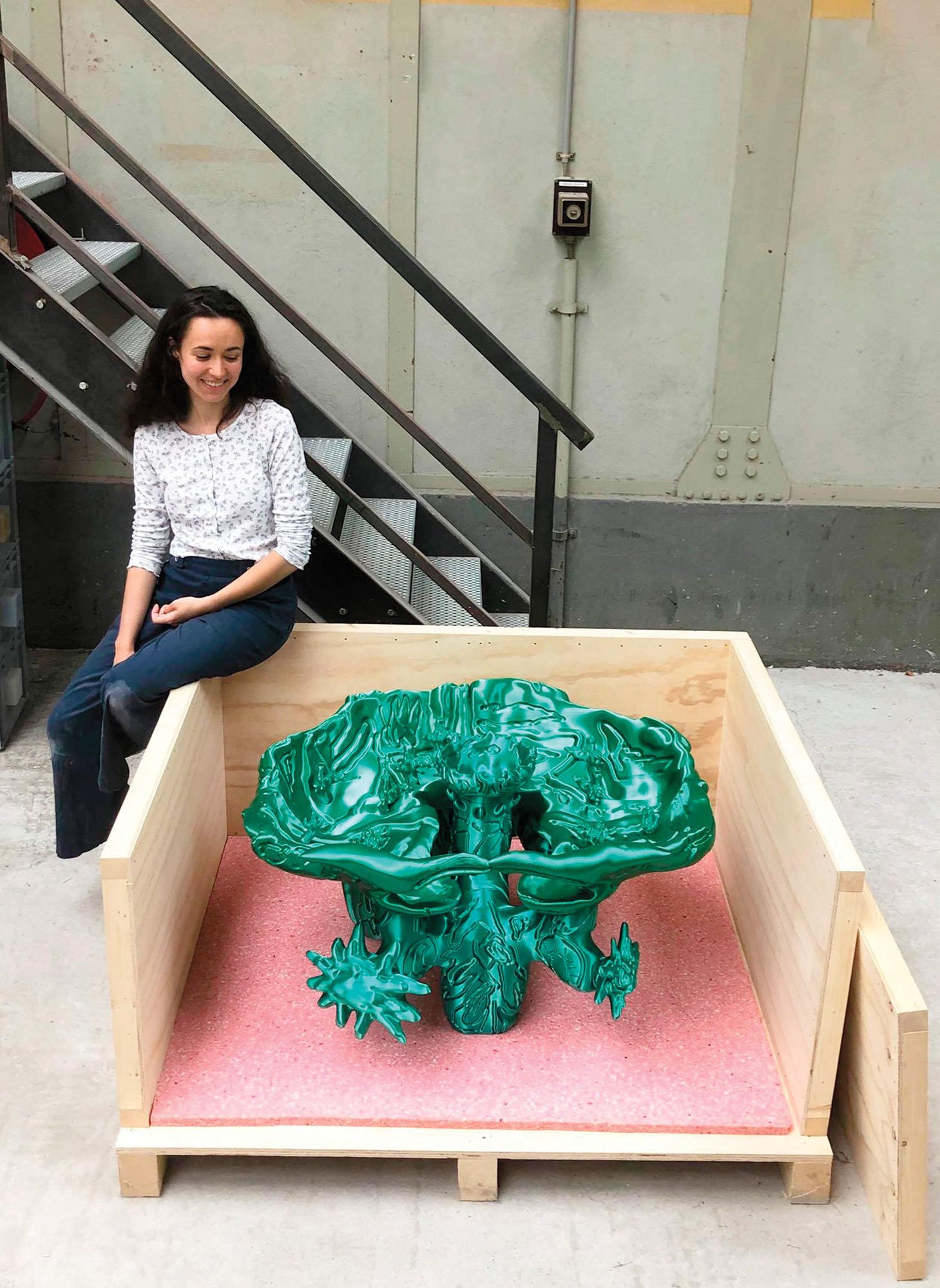
February 9, 2022
Exploring the Potential of Interiors and Design Objects in the Metaverse
If there is one narrative that has been consistently marketed to designers and consumers alike, it’s that “a home is a reflection of the self.” It’s a statement that encourages us to buy products and express ourselves via the things we collect and display in our houses, on our bodies, and through our online profiles. There’s some truth to it—the stuff we surround ourselves with holds histories, tells stories, and even serves as a metaphor for our identities, lives, and dreams.
This quest for creative individuality has only been magnified by digital platforms and social media, from Pinterest and Instagram to TikTok and Fortnite. Like everyone else, designers—hoping to broadcast their voices and challenge the monotonous, fickle dictates of good design—find potential for greater embodiment and self-expression in the digital. Enter the metaverse to make things even more complex.
While it’s not a new concept, the recent buzz around both the metaverse (largely thanks to Facebook’s recent rebrand to Meta) and the rise of non-fungible tokens (NFTs) has led to an influx of interactive digital design objects and interiors, whether they’re online exhibitions, virtual showrooms, or even gatherings hosted in simulated environments.
NFTs:
Non-fungible tokens, or NFTs, are unique and non-interchangeable units of data (in the form of photos, videos, audio, etc.) that can be stored on blockchain, sold, and traded.
In theory, the metaverse is a location or series of locations where one can enter a digitally rendered space, move around as an avatar, and interact with objects, all through virtual, augmented, and mixed reality. Facebook (now Meta) founder Mark Zuckerberg describes it as a more “embodied internet.” But in a world where there is no longer a distinction between “real” and “digital,” the metaverse can elicit feelings of both freedom and fear, excitement and apprehension. For decades, scholars and designers alike have questioned what prolonged enmeshment in virtual reality does to both our mental and physical health.
In a best-case scenario, the possibility of the metaverse as a positive, equitable tool for experiment and expression can be examined using the framework of glitch feminism, a concept coined by New York–based curator and writer Legacy Russell in her 2020 book Glitch Feminism: A Manifesto. She writes: “Imbuing digital material with fantasy today is not a retro act of mythologizing; it continues as a survival mechanism. Using the internet to play, perform, and explore still has potential. Giving ourselves this space to experiment perhaps brings us closer to a projection of a ‘sustainable future.’” Using memoir and contemporary art as an anchor, Russell’s book serves as a Black, queer cyberfeminist manifesto for the new digital era, exploring how the “glitch,” or gap between digital reality and possibility, can be a site of liberation between body, technology, and gender.
Glitch feminism:
In computers, the “glitch” is normally thought of as an error, a fault, or a fissure, but in her 2020 book Glitch Feminism: A Manifesto, writer and curator Legacy Russell reframes the glitch as a site of liberation between body, gender, and technology. For her, the glitch offers an opportunity to infinitely transform ourselves and our identities. She writes: “The glitch creates a fissure within which new possibilities of being and becoming manifest. The digital world provides a potential space where this can play out. Through the digital, we make new worlds and dare to modify our own. Through the digital, the body ‘in glitch’ finds its genesis.”
Through a series of radical demands, Russell’s writing emphasizes that online, one can exist outside the binary thinking of capitalism, white supremacy, heteronormativity, or other rigid norms. They can build an avatar that is fluid, transformable, human, or nonhuman, and their cyber-identities and digital skins can contain the power to fragment, shape-shift, glitch.
One clear example of Russell’s “sustainable future” realized in the digital realm is the Black Artists + Designers Guild (BADG) Obsidian Virtual Concept House, an Afrofuturist dwelling conceptualized in early 2021 by 25 BADG creatives. Not only could guests virtually shop there for products and fixtures specified by the home’s creators, but they could take part in a monthlong calendar of online programming. The concept house itself was designed to be a safe and liberating space for “expressions of joy and creativity,” with every room and space stemming from the personal narratives of the designers.
BADG
In January 2021, The Black Artists + Designers Guild (BADG) created the Obsidian Virtual Concept House. The home was designed by Leyden Lewis and Nina Cooke John as a safe space for BADG creatives to share their individual family histories as well as individual approaches to design. One example is artist Cheryl R. Riley’s “Sanctuary” room, a dreamlike space that embodies the artist’s exploration of meditation and ancient spiritualities.
In the metaverse, objects are not static. Just like the people and avatars who produce and interact with them, they have the potential to contain infinite versions of themselves. The prefix meta can connote movement, among other meanings, and it has this sense in many words that denote change, transformation, or transcendence, as in metabolism, metaphysics, or metamorphosis.
This undefined malleability of virtual reality can be seen in the eroticized, hyperreal cyberpunk world of Anthony Authié, founder of Paris-based design firm Zyva Studio. Strongly influenced by the “composite aesthetics of mythological and trans-human creatures such as the minotaur or the cyborg,” many of Authié’s digital interiors don’t even appear to be designed for humans. The designer coined the concept of trans-design to describe his practice and how it incorporates themes and images of the body derived from fiction and subcultures—from extreme fitness and plastic surgery to reality TV and Japanese manga.
Hyperreality:
Coined by French sociologist Jean Baudrillard in his 1981 text Simulacra and Simulation, “hyperreality” describes a representation or a sign that lacks an original referent. In other words, hyperreality signals an inability to distinguish reality from a simulation of reality.
Cyberpunk:
This subgenre of science fiction focuses on a dystopian future that combines elements of artificial intelligence, cybernetics, and social change. The term “metaverse” actually was coined by Neal Stephenson in his 1992 book of the genre, Snow Crash.
“What’s interesting to me about virtual space is that bodies can contort themselves endlessly, have supernatural strength, or various robotic or mechanical elements,” Authié explains. “The skin can become soft like cotton or break like glass. So, depending on its use, the body in virtual space can allow us to change the perceptions we have of it.” And when we alter perceptions we have of the body, we alter perceptions of the objects that are scaled to it, potentially freeing them from the passivity of being used by humans, and toward becoming active themes, characters, or metaphors in the scripts of our personal lives. In the metaverse, a chair could smile back at us, or even get up and move about the room.
ZYVA STUDIO
In 2019, Anthony Authi of Zyva Studio coined the concept of trans-design as a hybrid architecture marked by composite aesthetics of mythological and trans-human creatures.
For Brooklyn-based furniture designer Misha Kahn, “digital spaces have always been an opportunity to express and present yourself.” Yet he notes that many of these so-called dreamscapes are about “promoting aspirational ideas,” adding, “[These spaces] could’ve been filled with the richness of fantasy and narrative but were just getting co-opted to sell fancy-looking objects that don’t exist.” In response to this frustration, in August 2021, the 32-year-old designer produced Misha Kahn: Furniture Unhinged, a series of ten digital and physical objects that were the first design NFTs offered at a major auction house, Christie’s.
Dreamscapes:
A digital art and design movement defined by fictional digitally rendered interiors and objects that often take on fantastical and surrealist themes.
The project begins as a 13-second animation (created by Ryan Decker, an artist and studio assistant at Kahn’s studio) in which a gooey biomorphic form mutates into various furniture types. But unlike many other design NFTs, which merely sell the image of an object, Kahn approaches his as blueprints for physical designs. Each NFT includes an MP4 “trophy” of the object as well as a 3D model, so the buyer has the ability to print it either on their own or through the designer’s studio. For Kahn, there is a freedom in digital production methods that is a departure from the “impersonal” nature of the contemporary furniture market, in which objects can be made from American materials, produced in China, finished somewhere else, and then shipped to you from across the world. The idea of NFT as blueprint allows the end user to live exclusively with the digital object, or if they want to produce a physical version, use localized methods that eliminate supply chain complications while providing a unique object.
For now, the trading of objects through NFTs remains a rarefied field, much like the world of collectible design. This explains why auction houses and galleries have taken the lead in promoting virtual spaces and objects. For Stephen Markos, a collector, curator, and founder of Superhouse, a New York–based gallery and digital platform that has shown work from Kahn, Gaetano Pesce, and Katie Stout, among others, digital spaces and NFTs will keep evolving as a method to produce more-experimental works. But in the current market, he says, “I don’t think that a lot of collectors that are buying ‘collectible design’ are buying as many NFTs that only live in the digital world.”
The underlying functional economy of the metaverse could eventually lead to the design of digital spaces that, even more than our social media profiles, will serve as a second home, encouraging anyone to amass digital currency and decorate their digital worlds. Kahn likens the idea to millennials sitting in their home’s computer room in the early aughts customizing their Myspace pages with original backgrounds and graphics. Many of them didn’t even realize they were actually changing the code of the page, and that’s the thing: In the metaverse, everyone will become an interior designer, whether they realize it or not.
MISHA KAHN
Brooklyn-based designer Misha Kahn asks, “What if we consider all the ways in which objects in the metaverse can be really different?” Last year the designer created multiple animated NFTs that attempted to answer this question, starting with Furniture Unhinged, the first series of design NFTs to be sold through a major auction house. The second, Factory001, was launched during Design Miami as a virtual machine that can infinitely produce unique digital objects.
It’s also hard to ignore the element of surrealism that pervades so many of these spaces and objects. Anthropomorphism, hybrid forms, and dreamlike imagery all point to tensions between the everyday and the unfamiliar, an ongoing collapse of the rational and functional, and a deep exploration into the boundaries of reality and consciousness. Like surrealism and science fiction, the material culture of the metaverse will underscore the inseparability of human and nonhuman, real and digital, object and person. By attributing traits and personalities to digital furniture and objects, we are able to unlock a better understanding of self and potential worlds not yet possible in a reality that is away from keyboard.
AFK:
In the early days of internet chat-speak, “AFK,” or “away from keyboard,” was a simple way to let people know that you were stepping away from your computer. In Glitch Feminism, Legacy Russell supplants the popular use of “IRL” (in real life) with “AFK” as a way to point out that the distinction between the “real” and “digital” worlds is just another false binary.
Ultimately, the spaces and objects of the metaverse might be reflections of self, but, like all technology, they also reflect the society that produces them—biases, power structures, and all. Maybe at the hands of the tech giants, uniqueness is yet another unattainable aspiration. But so far, at the hands of many designers, the interiors and objects of the metaverse defy definition and categorization, inching us closer to a design world free from the confines of society’s sameness.
AUDREY LARGE
Audrey Large is another designer who is actively complicating the relationship between image and object—real and digital—through 3D scanning, modeling, printing, and virtual exhibitions. “My work uses the computer as a space with its own rules, not as a space for the simulation of the real,” she says. In a new online exhibition organized by Milan’s Nilufar Gallery, visitors can interact with the designer’s digital files in a way that communicates her process more than simply being a representation of a physical exhibition.
ALEX PROBA
ALEX PROBA
At last year’s Design Miami, Alex Proba, founder and creative director of Brooklyn- and Portland, Oregon–based Studio Proba, debuted Tomorrow Land, a public installation designed in collaboration with creative technology studio Enjoy the Weather, which transformed Miami’s Design District into a physical and virtual playground. An accompanying app allows anyone to digitally design and explore through augmented reality. Two NFTs—rendered by artist Ariel Palanzone—were auctioned off to support free education programs for children in underprivileged communities.
ORTAMIKLOS
In August 2021, design duo Leo Orta and Victor Miklos Andersen launched their digital exhibition-cum-videogame, Memory Foam, in collaboration with design galleries Superhouse and Friedman Benda. Players in the game take on the persona of one of OrtaMiklos’s anthropomorphized sculptural chairs while traversing a postapocalyptic digital landscape created by artist Guillaume Roux. COURTESY ORTAMIKLOS
Top of Page: FROM LEFT TO RIGHT: COURTESY ZYVA STUDIO; COURTESY ORTAMIKLOS; COURTESY ALEX PROBA; COURTESY AUDREY LARGE
Would you like to comment on this article? Send your thoughts to: [email protected]
Recent
Projects
5 Buildings that Pushed Sustainable Design Forward in 2022
These schools and office buildings raised the bar for low-carbon design, employing strategies such as mass-timber construction, passive ventilation, and onsite renewable energy generation.
Projects
The Royal Park Canvas Hotel Pushes the Limits of Mass Timber
Mitsubishi Jisho Design has introduced a hybrid concrete and timber hotel to downtown Hokkaido.
Profiles
Meet the 4 New Design Talents Who Made a Mark This Year
From product design to landscape architecture and everything in between, these were the up-and-coming design practices making a splash in 2022.































